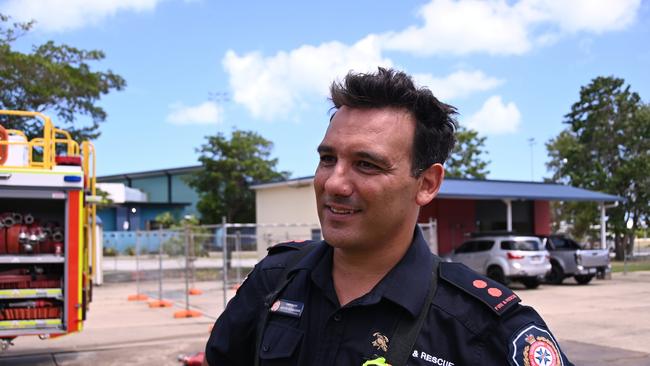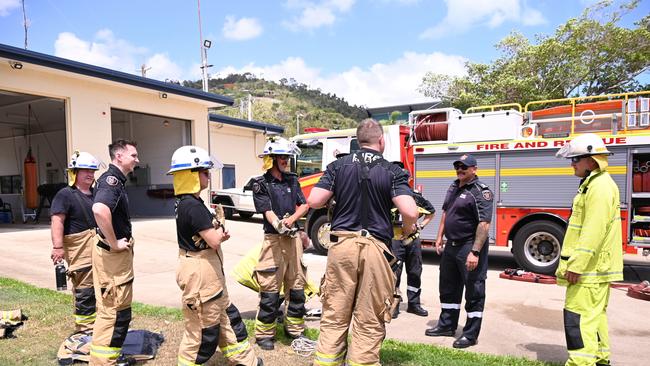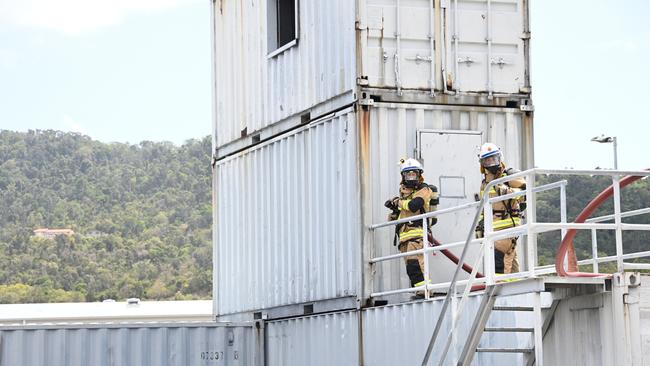HE answers every call that comes in on his pager from dusk to dawn, sometimes it means pulling an all-nighter to attend a crash or fire only to then rush to his day job on his way home, but being a firefighter is Justin Buhagiar’s calling.
For the past five years, the 42-year-old has trained and exercised as a part-time firefighter in Airlie Beach, while continuing his day job as an electrician.
Airlie Beach Fire and Rescue does not operate 24/7, and relies on everyday heroes like Justin to put on the uniform to respond to emergencies outside normal hours.
Justin moved to the Whitsundays from New South Wales five years ago, and after meeting local firefighters at an open day event he started at the fire station straightaway.
“Once I’ve started talking to the people here, … I just got involved and you know, I put a lot of effort into this, but the reward is unreal,” he said.
Justin had never trained as a firefighter in his life before but said it was an incredible job.
“It’s the adrenaline I think. You could be at home or at work doing your normal job, and then all of a sudden you get a pager, you got to head to the station, get changed, jump into the truck, get to the job, and when you get to the job there is a house fire or something like that,” he said.

Justin recalls one night he had two emergency calls.
The first was around midnight and next at 3am which means he didn’t return home until 6:30am the next morning.
“It was a false alarm, but it still could have been a fire. You have to treat every call the same way,” he said.
“And being an auxiliary, we all have our jobs, so I got home at 6:30 and then I started work at 7 o’clock.
“It can become overwhelming, but knowing that you’re saving something or someone, it’s a great experience.”
Making changes in his everyday life does not only involve a lack of sleep, the father of a two-year-old boy also has to juggle family and work to attend an emergency.
It even means making adjustments to his social life with his partner.
“If we go out to dinner, we’ll always take two cars in case there is a fire call,” he said.
Justin can also be deployed to other parts of the state, to assist with major emergencies such as the wild bush fires in the Carnarvon Gorge that ravaged 300,000 hectares of land in early November.
“I had to email everyone, all my work was put on hold,” Justin said.
He was away for six days.
“Luckily, they were pretty understanding.”
Responding to the challenges of a regional station
A small station like Airlie Beach is often faced with the challenge of having to make do with the equipment they have on hand, knowing that it might not be enough in a major fire.
Airlie Beach Fire and Rescue station senior firefighter Nick Moss said the immediate response they are able to provide would be deploying two trucks, or receiving some help from Proserpine.
“If it’s bigger than that, then we need to manage the incident for the time that it takes for something to come from Mackay,” he said.
“We do get used to looking after ourselves and know that we’ve got to manage things from what we’ve got here.
“We’ll risk a lot for savable lives.”

Mr Moss said the work of auxiliary firefighters was invaluable in a small North Queensland town, and that it was important to have opportunities for both teams to train together, reassess everyone’s levels and make sure each person is up to date with the “doctrine procedures” that govern firefighters.
The last combined training of the year
On a recent Saturday morning training Airlie Beach Fire and Rescue station manager Rees May explained the drill to his team and to the auxiliaries.
Everyone knows what to do, it’s a game of pretend.

In the exercise two cars caught fire next to a building and the fire spreads to the building.
The first firefighter takes the hose straight away and keeps his distance from the blaze, while a female team member puts on her breathing apparatus and takes over the hose.
The breathing apparatuses lets her get much closer to the fire.
The first firefighter then does the same, putting on his breathing gear and the helps with spraying water on the blaze.
Team members then turn their attention to the structure near the fire and spray water from above before coming back down when the structure gets too involved.
“It’s difficult to treat it like it’s real when there’s no actual fire in front of you,” Mr Moss said.
But the exercise is worth it because if they know the procedures inside out, then after it’s “muscle memory” on the day there is an actual fire, and they can “focus on the situation at hand”.


Watch: Moment cops catch sauced Suzuki driver at servo
“You’ve been drinking while you’ve been sitting here”, a police officer tells an alleged drunk driver in an unbelievable exchange caught on camera. SEE THE VIDEO.
Tragic way truckie was killed in horror Gateway Mwy fatal
Police have revealed how a truck driver was killed on the Gateway Mwy in Brisbane’s east yesterday morning from an incident that caused massive peak-hour delays.